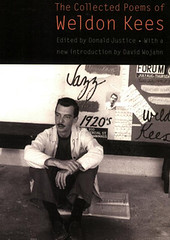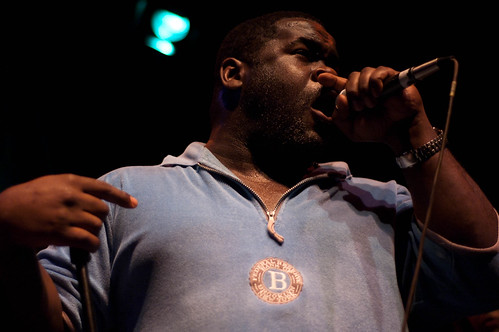 Hannah ThonetmuMs is one of the poets scheduled to perform at Joe’s Pub, Thursday evening.
Hannah ThonetmuMs is one of the poets scheduled to perform at Joe’s Pub, Thursday evening. Hurricane Sandy wrecked the HVAC system at the Nuyorican Poets Cafe, leaving the storied performance space without heat.
In an email to The Local, executive director Daniel Gallant said that while “relatively warm weather and the use of small space heaters have allowed us to continue running our programs for the past few weeks, it will be difficult for us to remain open as the weather gets colder unless our heating system is replaced.” There are also concerns about burst pipes when the freezing weather finally arrives.
The cost of replacing the system is estimated at $27,500. The Cafe, like other local businesses, also suffered loss of revenue due to the post-hurricane power outage and canceled events. This Thursday’s fund raiser at Joe’s Pub is just part of the recovery effort. Donations are also being taken at the website.
Pat Ivers and Emily Armstrong continue sorting through their archives of punk-era concert footage as it’s digitized for the Downtown Collection at N.Y.U.’s Fales Library.
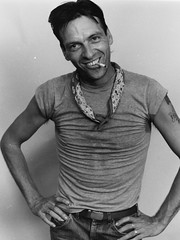 Emily Armstrong Max Blagg
Emily Armstrong Max BlaggAugust 1980 in the Lower East Side: it was the Summer of Heroin.
Clinton Street was not yet restaurant row – it was lined with shooting galleries, rows of cars with Jersey plates and steerers plying their wares. “We got Snoopy, 7-Up, Yellow Bag; we got the stuff that can kill you, man!” – a pitch both fascinating and confounding. Junkies were on every other corner and street muggings were rampant. Home break-ins were a fact of life so common that it became uninteresting unless it happened to you.
Which it did. We came home one night to find our apartment tossed and our video equipment gone. At the time, we were running the Video Lounge at Danceteria and our coworkers rallied to our support, organizing a benefit. Poet Max Blagg, then a bartender at the club, read his epic, “Smack Yourself Senseless.” His poem, a brutal five minute take-down of heroin chic, was a comfort. Read more…
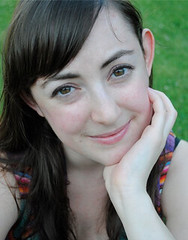 Courtesy Leigh Stein
Courtesy Leigh SteinAt 7:30 tonight, Leigh Stein, a novelist and former editorial staffer at the New Yorker, will read from her new book of poetry, “Dispatch from the Future,” at Bar on A. We spoke to the Brooklynite about bad dates in the East Village and an awkward shopping trip to the St. Mark’s Bookshop.
Q.
The trailer for your new poetry collection begins, “I can’t go to the East Village anymore…” How do you feel about coming back to the neighborhood for your book reading?
A.
I love the neighborhood but I avoided it for years because it brought back weird, painful memories. Now I’ve grown up a bit, and can enjoy life again. Bar on A is actually one of my favorite bars in the area. I had a “Where the Wild Things Are”-themed birthday party there a few years ago. I wore a faux fur stole. Read more…
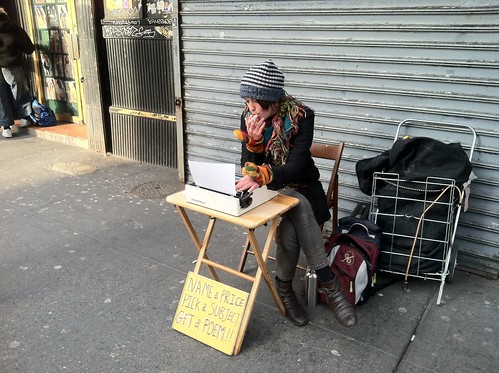 Stephen Rex Brown The poet at work.
Stephen Rex Brown The poet at work.A 20-year-old itinerant poet was offering up stanzas on the cheap today, and she even penned an ode to St. Marks for The Local.
Abigail Mott had set up at St. Marks Place and Third Avenue with a typewriter and a sign saying, “Name a price, pick a subject, get a poem.” A four-person film crew shot her every move. Read more…
A cultural oddity of the East Village is that it has more often been a home to poets than novelists. Some of the poets (Allen Ginsberg, W.H. Auden) are about as famous as poets get. Others (Edwin Denby, Bernadette Mayer) are known to only a few. The vast majority, as you would expect, are almost completely unknown.
Weldon Kees, who lived at 129 E. 10th Street (the apartment building directly next to St. Mark’s Church) from October 1943 until November 1945, and later rented a loft at 179 Stanton Street in the Lower East Side, is an exception. As a cult figure with an ardent following, he’s certainly known to some people – but his connection to the East Village has been all but forgotten. Perhaps that’s appropriate: An absence as much as a presence, a shadow where a human should be, Kees is the Harry Lime of modern American poetry, as in the character played by Orson Welles in “The Third Man”: Now you see him, now you don’t. Read more…
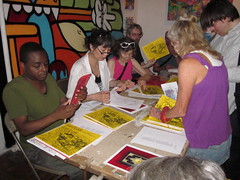 Meghan Keneally The ‘assembly’ portion of the magazine is literal.
Meghan Keneally The ‘assembly’ portion of the magazine is literal.Nearly two dozen people walked past the “For Sale” sign and closed gate of a townhouse on Third Street on Sunday, invited themselves in the unlocked door, and made their way up to the second floor with folders of their work in tow.
When they walked in, it was like a mini reunion of yesteryear’s East Village art world: everyone knew each other, liked each other’s work, and swapped stories about peers of old.
And then they got to work publishing a magazine.
They were all there to put together the 34th issue of “What Happens Next,” an assembly magazine made up of poems, collages and drawings. The event, and the 33 issues prior, have been organized by Eve Packer who started it “just to have a forum” for the work of she and her friends, and anyone else who wanted to jump in.
The magazine is made up of individual work provided by the participants, with each bringing 100 copies of their pieces. The assembly aspect of the magazine is very literal: everyone lines their stack up and they start passing it along, with one person at the end taking charge with a stapler.
Read more…
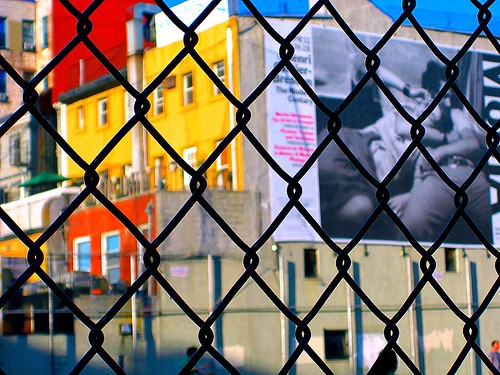 Michelle Rick
Michelle RickCities are unforgiving places, and New York perhaps the least forgiving of all.
One of its less attractive traits has always been its self-mythologizing triumphalism and I ♥ NY campaigns, a localized form of the nationalism it derides in the rest of the country. “If I can make it there, I’ll make it anywhere,” Frank Sinatra sang in what has become Manhattan’s unofficial national anthem and New Year’s rallying cry. It’s a sentiment to which countless scrambling citizens still subscribe. If they can just work hard enough, be ingenious and ruthless enough, they too will be “king of the hill / Top of the heap,” because this is the place. Or so we like to think.
Is it, though? Just over a century ago, C.P. Cavafy (1863-1933), an enduringly popular Greek poet who lived in Alexandria, Egypt, wrote a 16-line poem called “The City” which immortalizes a peculiarly urban dilemma whose outlines disenchanted New Yorkers will readily recognize. Those who have just moved here should read the poem, memorize it, print it out, and stick it on the fridge door.
Read more…
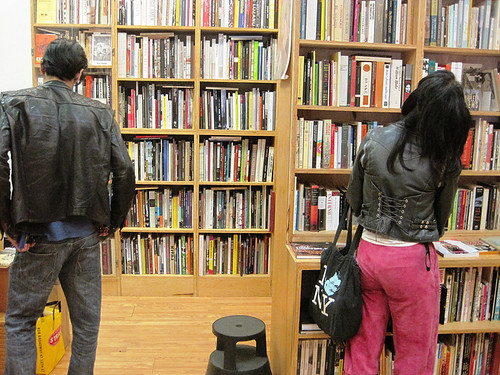 Brendan BernhardBrowsers at Mast Books.
Brendan BernhardBrowsers at Mast Books.On May 8, Mast Books, which takes up about 450 square feet at 66 Avenue A, sailed into its second year as a viable new business in the East Village. Why “Mast”? Is Bryan Leitgeb, who owns the store together with his wife, James McKee, a secret fan of Patrick O’Brian, C.S. Forester, and other icons of nautical literature? Smiling at this idea, Mr. Leitgeb shakes his head but says he prefers not to reveal why his store should have such a singular name.
Mr. Leitgeb, 37, who came to New York from Flint, Mich., is already a veteran of the city’s used-books business. (He spent seven years at Mercer Books alone.) He is also confident that he has hit upon the right business formula in the right place at the right time. Unlike East Village Books, long a fixture at 99 St. Marks Place, Mast has the air of a used book store acutely aware it is in the midst of an intellectual revolution that has raised the image far above the word.
This knowledge is Mast’s secret. With its polished wood floors, white walls, track lighting, and eye-catching display tables, it doesn’t look “used” or “second-hand” in the slightest. On the contrary, it is designed to evoke a small art gallery and to attract similarly chic crowds, although its strong neighborhood ethos prevents it from feeling in any way exclusionary. Mr. Leitgeb, whose blue eyes are alternately melancholy and highly focused, does his part to make non-hipsters feel at home by going unshaven, wearing non-designer glasses, and a brown cap unlikely to be featured in the next edition of Vogue. More importantly, he’s also unsnobbish, helpful, and friendly.
Read more…
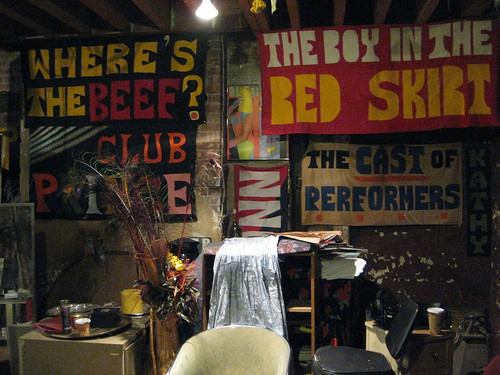 Kim Davis
Kim DavisClimbing the rickety, makeshift stairway of the century old former tenement building on East Third Street that houses the Nuyorican Poets Café there was little to foretell the treasure trove Kim Davis and I would encounter. Daniel Gallant, executive director of the Nuyorican, explained that few know of the existence of the archives we were set to explore, and even fewer got to view this lofty realm as the Café has no certificate of occupancy for the top three floors of the building, which are not open to the public and are used strictly for storage. Daniel described how poet Miguel Algarín, and the Café’s other founders, had acquired the building from LaMama Theater creator Ellen Stewart in 1980 and established a venue where Lower East Side poets, playwrights and musicians could present their work.
After Daniel unlocked the padlock fastened to a small piece of plywood serving as a makeshift door leading to the third floor, we crouched to squeeze through the narrow entryway. As we ascended the stairs, the exposed brick walls were crowded with posters, paintings and costume designs from former productions held in the performance space occupying the first two floors of the building. Reaching the top of the stairs we entered a dimly lit, open loft space crammed in virtual disarray with a treasure trove of costumes crowded on racks, stage props, banners, posters and a vast collection of bric-a-brac accumulated over more than thirty years.
Costume designers have borrowed some of these period outfits for use in recent films. A large sign for one of the Nuyorican’s landmark productions, “Julius Caesar Set in Africa,” hung on the wall. As we wandered about the floor, it was difficult to appreciate everything. Exposed brick walls, fireplace mantles, thick wooden rafter beams were the only remains of the former railroad apartments that had existed in the building’s former tenement incarnation.
Dan regaled us with the history of numerous Nuyorican productions which had their sets and costumes created in this space. Tony Award winning playwright and actor Sarah Jones began her career with her first solo show, “Surface Transit” at the Nuyorican in 1998. She recently returned for a two week engagement after a Broadway run of “Bridge and Tunnel.” A sewing machine, paint cans, bolts of fabric, containers holding glitter, jars full of buttons, rolls of yarn and thread were evidence of the many hours that artists and writers like Sarah Jones “Bridge and Tunnel” and Miguel Piñero (“Short Eyes”) labored in the space. Read more…
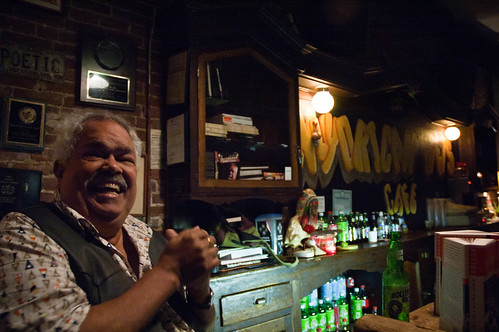 Hannah Thonet Miguel Algarín, founder of the Nuyorican Poets Cafe, still delights in showcasing artists at the organization he established nearly 40 years ago.
Hannah Thonet Miguel Algarín, founder of the Nuyorican Poets Cafe, still delights in showcasing artists at the organization he established nearly 40 years ago.On a gray August afternoon, walking through Tompkins Square Park, I saw dozens of poets huddled behind the bandstand, waiting to read from their own work or participate in an orchestrated performance of Allen Ginsberg’s iconic poem “Howl!” I joined the spectators, outnumbered by the poets, on seats scattered in front of the stage.
If the poets and visionaries of Ginsberg’s youth were “starving, hysterical, naked,” this sample of contemporary New York bards seemed calm and was fully dressed against the threat of light rain. As for starving, we all know there’s no money in the game. The audience for poetry sometimes seems to consist only of other poets, and almost nobody publishes a book of poetry expecting to make money. As one of the dedicated few who haunt poetry readings, and as an occasional poetry performer myself, I wondered how the poetry centers of the East Village were surviving this inhospitable economy.
Read more…







